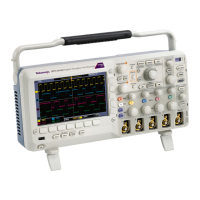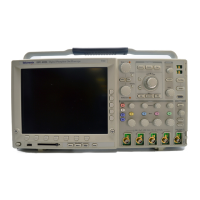
Do you have a question about the Tektronix DPO5054B and is the answer not in the manual?
| Brand | Tektronix |
|---|---|
| Model | DPO5054B |
| Category | Test Equipment |
| Language | English |
Review safety precautions to avoid injury and product damage.
Guidelines for using power cords, grounding, and disconnecting probes properly.
Information for safely performing service procedures on the product.
Lists EMC standards and declarations for the instrument.
Details safety standards and certifications the product complies with.
Instructions to prevent electrostatic discharge damage to the instrument input.
Information on power supply requirements and power consumption.
Procedure for safely powering off the instrument.
Steps to restore the instrument's operating system using the hard disk file.
Describes the instrument's interface elements and display components.
Identifies and explains the controls on the instrument's control panel.
Identifies and explains the controls on the MSO5000B/DPO5000B control panel.
Procedure to verify the instrument's functionality using internal diagnostics.
Procedure to perform signal path compensation for accurate measurements.
Steps to connect and set up analog signal input for acquiring signals.
How to use Autoset to quickly configure the instrument for signal acquisition.
Guidance on optimizing measurement accuracy via probe compensation and deskew.
Explanation of trigger events, modes, and trigger holdoff.
How to modify basic and advanced trigger parameters.
How to use A and B triggers for capturing complex signals.
Using B-Event Scan for overlapped eye diagrams synchronized by A trigger.
How to create trigger conditions directly on the display screen.
How to use horizontal delay to acquire waveform detail in a separated region.
Using Wave Inspector controls for efficient work with long waveforms.
Steps to set up a visual search using trigger settings and display marks.
How to take automatic measurements using the Measure setup.
Customizing measurements using gating, statistics, or reference levels.
How to use cursors for manual measurements on acquired data.
How to display vertical or horizontal histograms for statistical data.
How to create math waveforms from channels and reference waveforms.
How to perform spectral analysis using predefined math expressions.
Using the Serial Error Detector for Bit, Frame, Symbol, and Character tests.
Comparing signals to predefined templates or masks.
Comparing active signals with template waveforms for pass/fail testing.
How to capture intermittent anomalies using FastAcq mode.
How to trigger on various bus types like I2C, SPI, CAN, USB.
How to trigger on NTSC, SECAM, PAL, and high definition video signals.
Steps to compensate the probe for accurate measurements.
Safety precautions for using the logic probe to avoid hazards.











